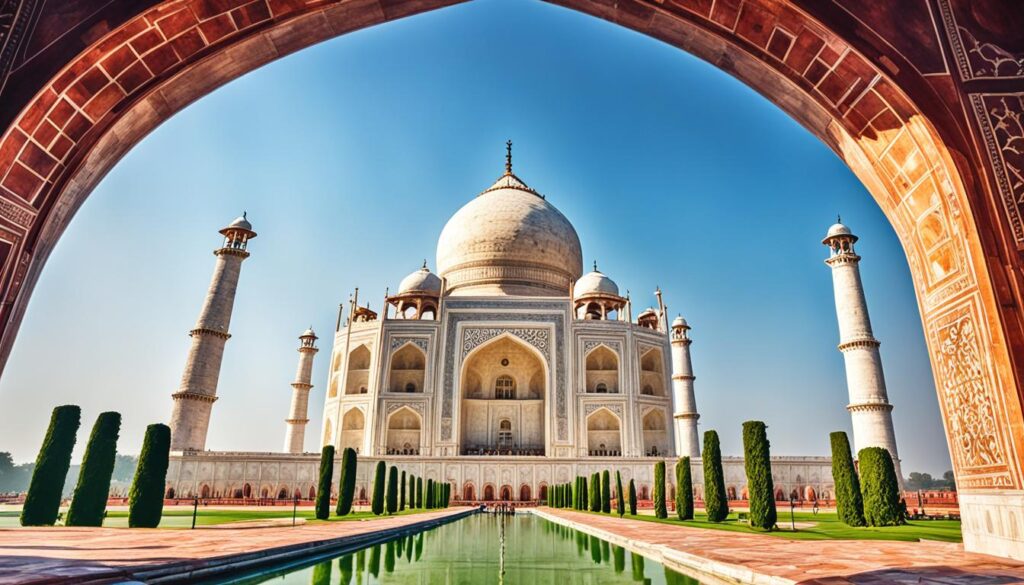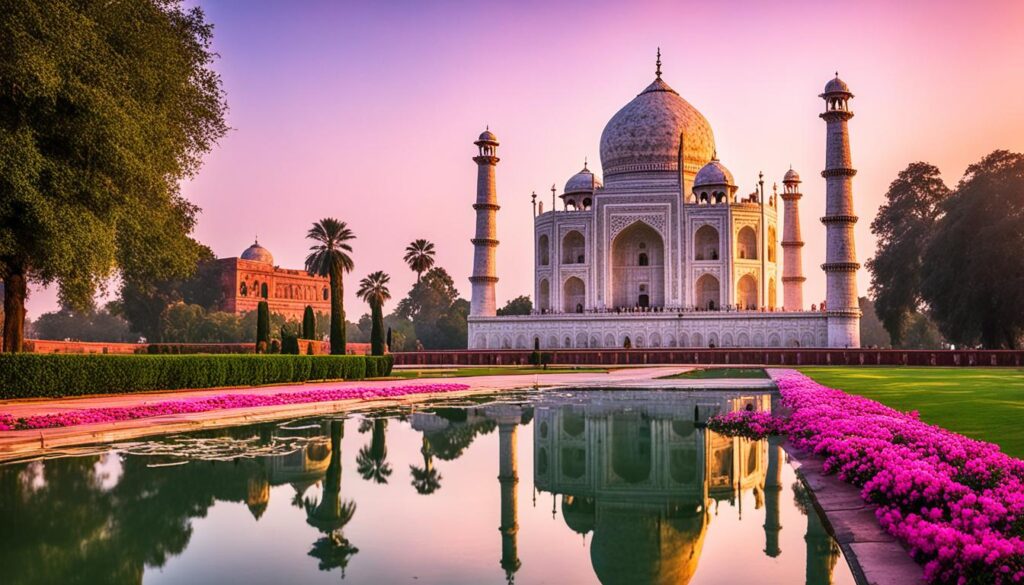The Taj Mahal, a top cultural wonder, stands in Agra, India. It shows the Mughal empire’s skill in architecture. Shah Jahan, the Mughal emperor, built it in 1632 for his wife, Mumtaz Mahal.
This amazing building mixes Persian, Islamic, and Indian styles. It’s a true work of art.
The Taj Mahal is a key example of Mughal architecture. It has detailed designs and a balanced look. Many people visit it, making it a Wonder of the World and a symbol of India’s culture.
Unveiling the Iconic Taj Mahal
The Taj Mahal is a true masterpiece of Mughal architecture. It shows the amazing skill and care of this time. Its perfect design, shiny white marble, and detailed gemstones and calligraphy make it a wonder of the world.
A Timeless Masterpiece of Mughal Architecture
It was built with white marble, showing the Mughal empire’s amazing building skills. The Taj Mahal’s design is symmetrical, with a central dome and four towers. The beautiful gemstones and calligraphy add to its beauty, mixing beauty with purpose.
The Story Behind Its Construction
Shah Jahan, the Mughal emperor, built the Taj Mahal for his wife Mumtaz Mahal, who died in 1631. It took over 20 years to finish, with thousands of skilled workers. The Taj Mahal shows Shah Jahan’s deep love and honors the Mughal empire’s architectural genius.
Cultural Wonders: The Taj Mahal’s Global Significance
The Taj Mahal is more than just a beautiful building. It’s a cultural wonder that touches hearts worldwide. As a UNESCO World Heritage Site, it shows off India’s deep cultural roots. People from all over come to see its beauty and learn about India’s history.
This place is not just pretty to look at. It’s a key part of India’s cultural story. It shows the skill of the Mughal Empire in art and engineering. Visitors are amazed by the detailed designs and symbols all over the Taj Mahal.
The Taj Mahal is also a UNESCO World Heritage Site. This honor shows its great value to the world. It makes the Taj Mahal a top spot for those wanting to explore India’s history and culture.
Architectural Marvels of the Taj Mahal
The Taj Mahal in Agra, India, is famous for its stunning architecture. It combines Persian, Islamic, and Indian styles perfectly. Each part of this wonder is full of meaning and shows great care in its making.
Intricate Designs and Symbolic Meanings
The Taj Mahal’s marble work and calligraphy show the skill of its builders. Its symmetrical design, with a main building and four towers, shows balance and beauty. The tall towers reaching up symbolize the soul’s journey to the heavens.
The way light and shadow dance on the Taj Mahal’s white marble is magical. It looks like something from a dream. The use of precious stones like jasper, jade, and lapis lazuli makes it even more beautiful. These stones show how valuable the Taj Mahal is.
The Taj Mahal’s design is a true work of art. It mixes Persian, Islamic, and Indian styles beautifully. From the detailed marble work to its perfect shape, it shows the skill of Mughal engineers and artists.
The Poetry of Marble: A Visual Feast
The Taj Mahal’s stunning white marble facade is a true feast for the eyes. Its beauty and purity add to the monument’s magic. The marble changes colors and shadows with the light, showing the Taj Mahal’s poetic side.

Visitors are amazed by the Taj Mahal’s elegance and grace. It looks like it’s floating on the reflecting pool, giving a feeling of timelessness and peace. The marble’s perfect surface mirrors the sky and gardens, making the structure even more beautiful.
The Taj Mahal’s marble is more than just a building material. It’s a canvas for the sun’s daily masterpiece. The monument’s ability to move and inspire people shows the power of this amazing material. It also highlights the skill of the craftsmen who made it one of the world’s most famous buildings.
Exploring the Taj Mahal’s Exquisite Gardens
The Taj Mahal’s gardens show how architecture and nature can work together beautifully. They have a symmetrical layout, making them a peaceful place away from the city’s noise. Paths wind through the gardens, inviting you to walk and enjoy the calm.
The gardens’ design is a work of art, with perfect lawns, colorful flowers, and quiet fountains. Everything is arranged in a way that matches the Taj Mahal’s beauty. This makes the gardens and the building look great together.
An Oasis of Tranquility and Beauty
Walking through the Taj Mahal gardens, the city’s noise disappears. You hear the sound of water, feel the breeze, and see greenery everywhere. This creates a peaceful place to enjoy the Taj Mahal’s beauty.
The gardens are a peaceful spot away from daily life’s rush. You can walk the paths, look at the design, or just sit and soak in the calm. The gardens make your visit to the Taj Mahal unforgettable.
The Taj Mahal: A Monument to Eternal Love
The Taj Mahal’s lasting legacy is deeply tied to the love story that sparked its creation. Shah Jahan, the Mughal emperor, built it as a tomb for his wife, Mumtaz Mahal. It stands as a symbol of their deep and lasting love.
The Taj Mahal is filled with intricate details and architectural wonders. These remind us of Shah Jahan’s deep love for his queen. The marble inlays, domes, and minarets were all made to honor Mumtaz Mahal and their bond.
People from all over the world are drawn to the Taj Mahal’s beauty and its story. It symbolizes eternal love that continues to move and amaze everyone. The Taj Mahal shows how love can last forever and leave a lasting impact on the world.

When visitors see the Taj Mahal, they’re amazed by its size and beauty. But it’s the love story behind it that really touches their hearts. The Taj Mahal’s power to make us feel wonder and respect proves its lasting importance as a symbol of eternal love.
Preserving the Taj Mahal for Future Generations
The Taj Mahal is a world-famous monument facing big challenges to stay beautiful and strong. It’s a symbol of the Mughal Empire’s artistry. But, it’s threatened by many environmental issues.
Challenges and Conservation Efforts
Air pollution is a big worry for the Taj Mahal. The marble can get damaged by pollutants in the air. To fight this, rules have been made to limit car access and check the air quality.
Too many visitors also pose a problem. Millions come every year, which can harm the monument. Conservation groups are trying to manage this by controlling how many people can enter and when.
Restoring and caring for the Taj Mahal is key to keeping it beautiful. Experts work hard to clean it, fix any damage, and keep its detailed designs. This keeps the Taj Mahal a true work of art.
With a focus on sustainable tourism and protecting the environment, we can keep the Taj Mahal amazing for future visitors. It’s a symbol of love and culture. Keeping it safe is a job for all of us around the world.
Capturing the Essence: Taj Mahal Photography Tips
Photographing the Taj Mahal is a special way to capture its timeless beauty. It lets visitors keep the monument’s beauty alive. You can use various tips and tricks to make stunning, moving images.
Experience the Taj Mahal’s changing looks during the day. The monument changes a lot as the sun moves. You can take photos of its soft colors at sunrise, dramatic shadows at midday, and calm reflections at sunset.
Try new angles to make your photos stand out. Don’t just stick to the usual views. Use low angles to show the Taj Mahal’s height or aerial shots to highlight the garden’s symmetry. Always remember to respect the monument and avoid actions that could harm it.






